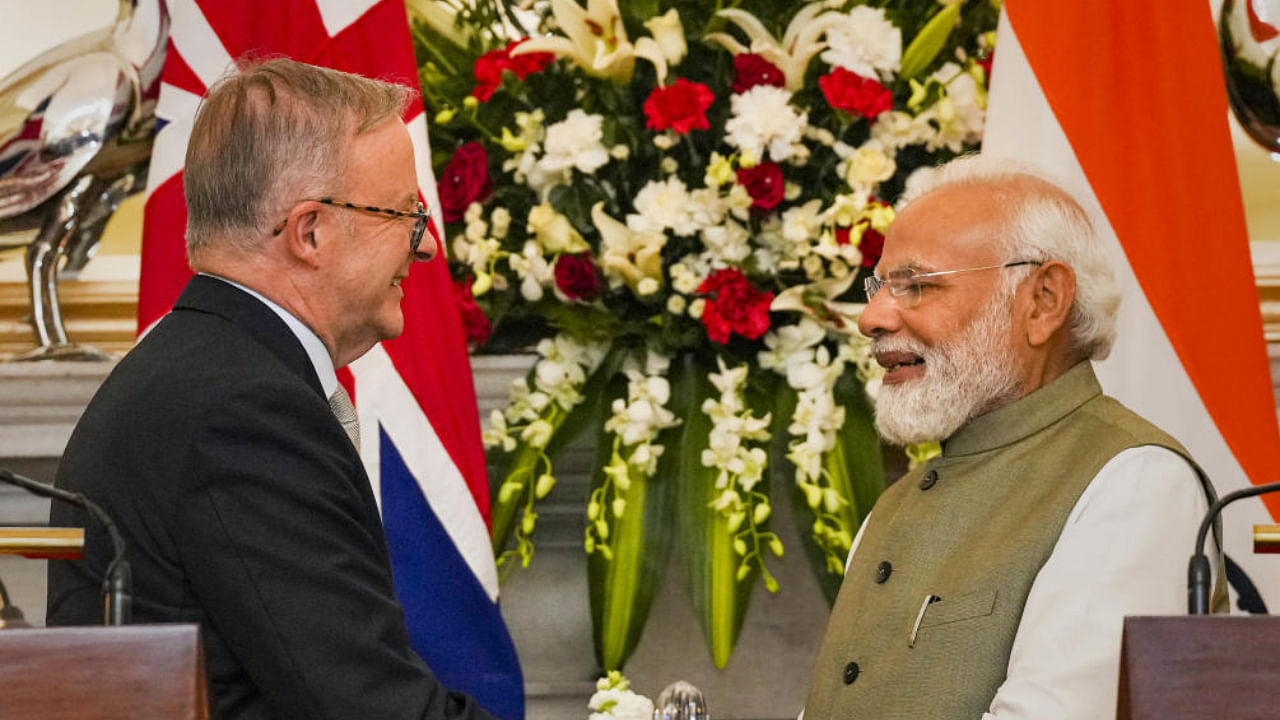
As the Prime Ministers of India and Australia took to cricket in Ahmadabad, Gujarat, the 120,000-plus stadium became a fitting symbol of India’s market potential which when matched with Australia’s economic heft can make for a profitable partnership.
It is not often recognised that Australia with a population little over Delhi-NCR combined, has a GDP per capita of Rs 49 lakh ($60,000) — this is just Rs 8 lakh ($10,000) less than the United States and Rs 8 lakh ($10,000) more than Canada. Outside of tiny countries such as Singapore and Luxemburg, it makes Australia one of the wealthiest in the world. India, with an economy set to grow at 7 per cent, has attracted Australia’s interest for a long time.
It is no wonder that Prime Minister Narendra Modi and his Australian counterpart Antony Albanese are concentrating on building the economic content of this evolving relationship. The trade component of the two large Indo-Pacific countries is miniscule. In 2022, Indian exports to Australia were just Rs 65,594 crore ($8 billion), while imports were Rs 1.31 lakh crore ($16 billion). In the post-Covid-19 world and with the changing global geopolitics, both are finding that they have an addiction to China which is proving hard to overcome.
In 2022, Australian exports to China were Rs 11 lakh crore ($142 billion), while imports from China were Rs 6.3 lakh crore ($78 billion). India’s exports to China were Rs 1.3 lakh crore ($17 billion), while imports were Rs 9.7 lakh crore ($118.5 billion). The thrust of Albanese’s visit is in trying to balance at least some aspects of New Delhi’s and Canberra’s China trade with an increase in bilateral trade. This has been a work in progress.
A comprehensive economic co-operation agreement between the two countries was signed in 2011. This visit leads to upscaling this into a comprehensive economic partnership agreement which Albanese outlined could lead to a free trade agreement (FTA). Australia and India have been negotiating an FTA for several years and if agricultural produce that both want to export and free movement of people and technology-sharing is agreed upon, it could at long last add some financial viability to the economic engagement.
India and Australia have signed the agreement on rare earth minerals which India is at an exploration stage, and Australia a leader. China has a strangle hold on some vital rare earths, and this is sought to be broken by both countries. India’s recent lithium find will lessen its reliance on imports, but Australia remains critical for other rare earths, such as cobalt.
Security Architecture
The security partnerships are gaining traction as members of the Quad — a partnership which both are at pains to not publicly call a security alliance. The two nations have engaged in bilateral, as well as multi-lateral, military exercises. This year, the Quad summit will be hosted by Australia, and the 2023 edition of the Malabar military exercise will also be off the coast of Australia.
Albanese’s visit to the Indian-made aircraft carrier is noteworthy as the role of maritime co-operation in this defence relationship is the centrepiece. Hidden in the fine print of the joint statement was a very significant point: “The Prime Ministers agreed that, as a practical step, India and Australia may continue to explore conduct of aircraft deployments from each other’s territories to build operational familiarity and enhance maritime domain awareness.” This is a step forward from exercises to actual deployment of aircraft in each other’s air and navy bases, including potentially anti-submarine spy aircraft on long deployments. This is a critical strategic outcome from the visit.
Canberra’s assurance to protect Indian minorities in Australia that have faced religious persecution as well as recognising Indian higher education degrees in Australia will enhance people-to-people contact.
The visit, thus, was incremental in progress. The ties remain hostage to the great distance between the two countries. Except for cricket, very little in the respective countries connect the ordinary people. This may change as and when Australia opens to more Indians. Foreign policy towards Australia is seen by New Delhi as a subset of its approach towards Washington—this is because on important matters Australia largely follows the US lead. So, managing Washington is perceived as managing Canberra.
For its part, while Australia believes in India’s economic potential and market size, India is not among its 15 top trading partners. As the two Prime Ministers formalise their summit to an annual affair, a lot more needs to fall in place for this very vital relationship to achieve full bloom.
(Ninad D Sheth is a senior journalist.)
Disclaimer: The views expressed above are the author's own. They do not necessarily reflect the views of DH.